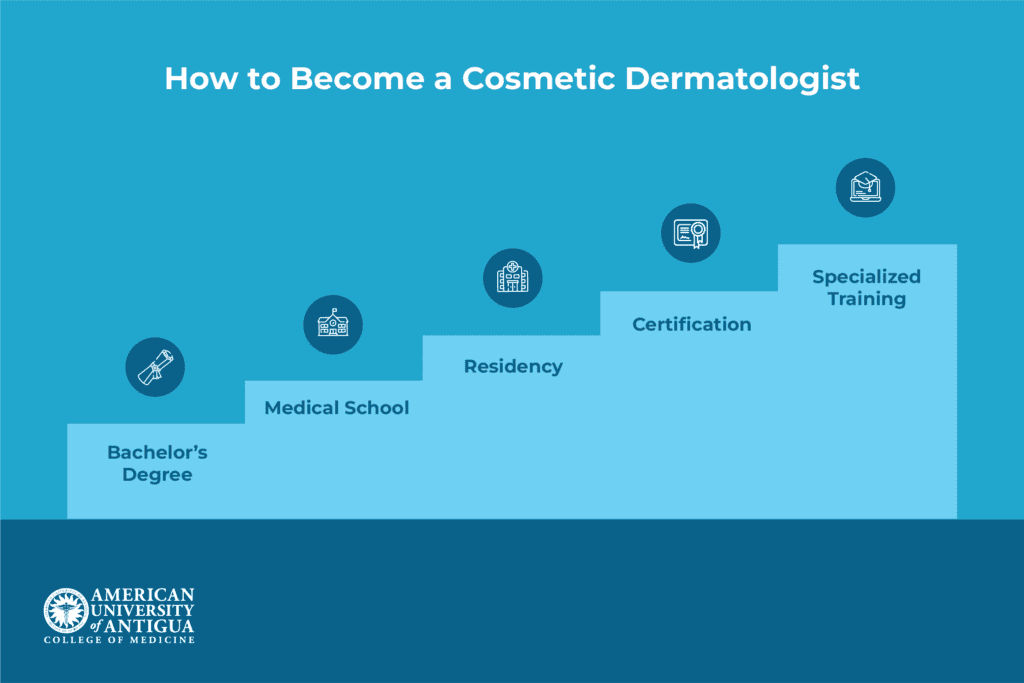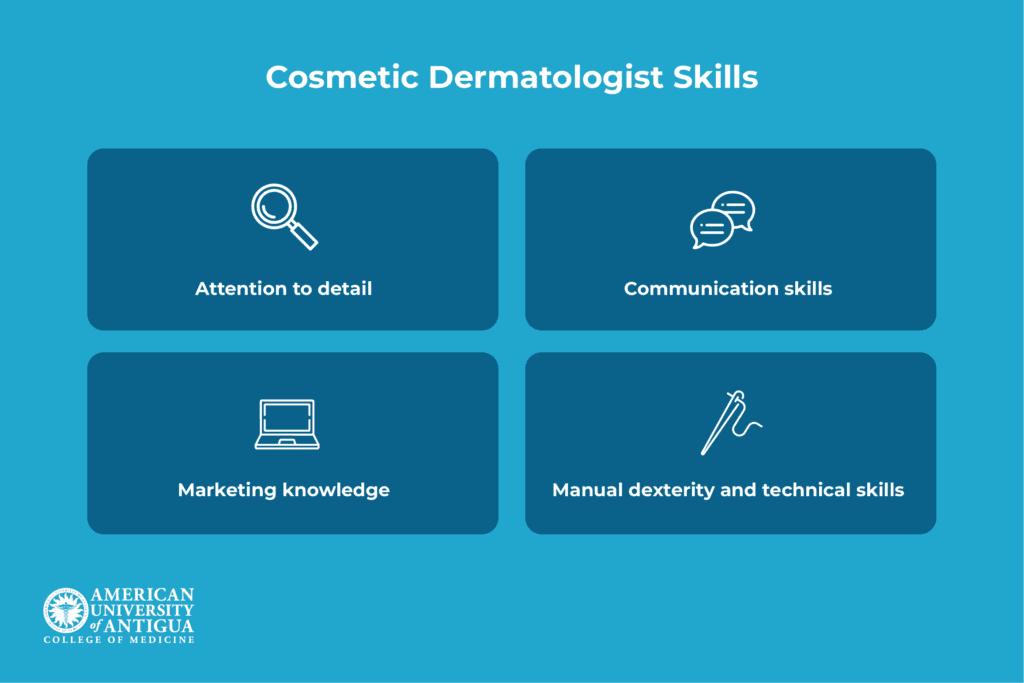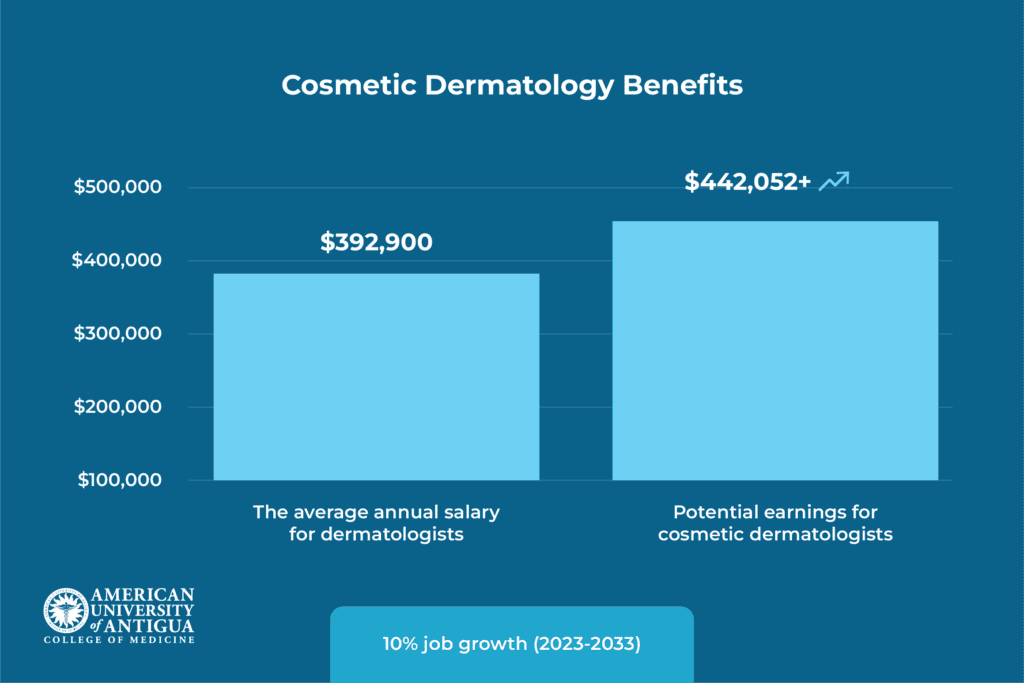How to Become a Cosmetic Dermatologist: Skills & Benefits
Key Takeaways
- Becoming a cosmetic dermatologist takes years of schooling, including earning a bachelor’s degree, finishing medical school, and completing a dermatology residency.
- Specialization also requires further training in cosmetic procedures like chemical peels and laser treatments.
- A keen eye for detail, artistic ability, clear communication, and technical proficiency in sophisticated procedures are essential for success in this line of work.
- Cosmetic dermatology is a rapidly growing sector offering great career development opportunities, high earning potential, and the chance to work with cutting-edge technologies.
A cosmetic dermatologist focuses on improving the appearance of the skin using non-invasive treatments, like laser therapy, chemical peels, and other beauty procedures.
The need for cosmetic dermatologists has increased as more people wish to improve their appearance without having surgery. This profession, which combines medical expertise with a sense of aesthetics, offers fantastic prospects.
In this blog, we will look at the steps to becoming a cosmetic dermatologist, the skills you need to succeed, and the many benefits of choosing this rewarding career path.
✅ Request information on AUA's MD program TODAY!
YOUR PATH TO SUCCESS BEGINS HERE
Steps to Become a Cosmetic Dermatologist

It takes years of study, practice, and certification to become a cosmetic dermatologist. It entails finishing medical school, obtaining the required licenses and certificates, completing a residency, and graduating from college. Those interested in cosmetic procedures may need more specialized training. Let us take a deeper look at each step in the paragraphs below.
Earn a bachelor’s degree
The first step to becoming a cosmetic dermatologist is completing a bachelor’s degree with a strong focus on science. Choosing a major like biology, chemistry, biochemistry, or pre-med helps build the knowledge needed for medical school.
Additionally, it’s crucial to maintain a good GPA (ideally 3.7 or higher) because medical schools are highly competitive and prioritize applicants with exceptional academic records.
Another crucial requirement is passing the Medical College Admission Test (MCAT), an exam that determines eligibility for medical school. Preparing well for the MCAT and maintaining good grades will improve the chances of getting into a top medical program.
Attend medical school
After finishing a bachelor’s degree, the next step is medical school, which takes four years to complete. There are two types of medical degrees: Doctor of Medicine (MD) and Doctor of Osteopathic Medicine (DO). Both paths provide the education and training needed to become a dermatologist.
Anatomy, pharmacology, and pathology are among the key topics covered in the first two years of medical school, which are primarily classroom-based. The last two years include clinical rotations, where students work with real patients in different medical areas, including dermatology.
To get into a dermatology residency, students need to score high on the United States Medical Licensing Examination (USMLE) because dermatology is one of the most competitive specialties.
Complete a dermatology residency
After finishing medical school, future dermatologists must complete a four-year residency program. In addition to a three-year dermatology residency concentrating on skin disorders and treatments, physicians complete a one-year internship in general medicine, where they acquire foundational medical knowledge.
Acne, eczema, and skin cancer are among the frequent skin conditions that physicians learn to detect and treat during their residency. They are also trained in treatments such as minor surgery and skin biopsies. Those interested in cosmetic dermatology may have the chance to practice treatments such as laser therapy and chemical peels.
Get licensed & certified
After finishing residency, dermatologists need to become board-certified to practice officially. To do this, they must pass exams from the American Board of Dermatology (ABD) or the American Osteopathic Board of Dermatology (AOBD). These exams test their knowledge and ability to treat skin conditions.
In addition to board certification, dermatologists must also get a state medical license. This license allows them to practice legally in their state and involves passing exams that meet each state’s specific requirements.
For those who want to focus on cosmetic dermatology, there are optional certifications in treatments like laser procedures. These extra certifications can help dermatologists improve their skills and expand their career opportunities.
Pursue additional cosmetic dermatology training
Dermatologists who want to specialize in cosmetic dermatology need extra training. They can take hands-on courses in procedures like laser treatments and other aesthetic treatments to learn new skills. These courses give dermatologists practical experience and are offered by specialized programs.
Besides formal courses, dermatologists can also gain experience by working in private practices, medical spas, or dermatology clinics, where they can practice with real patients and improve their techniques. This extra training helps dermatologists stay current with the latest cosmetic procedures and provide the best care for their patients.
Essential Skills Required to Become a Successful Cosmetic Dermatologist

Becoming a successful cosmetic dermatologist requires mastering several key skills. Aesthetic procedures like laser therapy or chemical peels require an artistic eye and meticulous attention to detail to get results that look natural. These procedures require precision to ensure patients look their best.
Since dermatologists must control patient expectations, explain treatments clearly, and give aftercare instructions, effective communication skills are also essential.
Additionally, having business and marketing knowledge can help dermatologists attract more clients and manage a successful practice, especially in the competitive world of cosmetic dermatology.
Finally, manual dexterity and technical skills are essential because many cosmetic treatments require steady hands and the ability to use advanced tools and techniques safely and effectively.
Benefits of Becoming a Cosmetic Dermatologist

Being a cosmetic dermatologist has many benefits, such as financial compensation and a promising future in the field. We’ll go into greater depth about these advantages in the sections that follow.
Salary
Cosmetic dermatologists typically earn higher salaries than general dermatologists because the procedures they perform are often elective, meaning patients choose them voluntarily and pay out of pocket. Dermatologists typically earn around $392,900 per year, but those specializing in cosmetic procedures can make significantly more.
Some cosmetic dermatologists earn over $442,052 annually, depending on their experience, location, and the number of treatments they provide. Since procedures like laser therapy and skin rejuvenation are not covered by insurance, patients must pay out of pocket, which leads to higher earnings.
The ability to set their own prices and manage private practices further enhances the financial benefits, making cosmetic dermatology a highly lucrative career choice.
Job outlook
Cosmetic dermatology is a fast-growing field because people are constantly seeking non-invasive beauty treatments, such as laser therapy and skin rejuvenation. As more people look for ways to improve their appearance with minimal recovery time, the global cosmetic dermatology market continues to expand. New technology and improvements in treatment methods are making these procedures more effective and easier to access.
According to the Bureau of Labor Statistics (BLS), the employment of skincare specialists, which includes cosmetic dermatologists, is projected to grow by 10% from 2023 to 2033, much faster than the average for all occupations.
This growth means there will be more job opportunities for cosmetic dermatologists, with increasing chances for employment and career advancement in both established practices and new cosmetic-focused clinics.
Is a Career in Cosmetic Dermatology the Right Path for You?
If you’re thinking about a career in cosmetic dermatology, it’s important to ask yourself if this field matches your interests, skills, and career goals. Do you enjoy helping people improve their appearance with non-invasive treatments? Are you detail-oriented and have an artistic eye for creating natural results?
This career also requires good communication skills, as you’ll need to explain treatments clearly to patients and manage their expectations. You’ll also need to stay updated with new technologies and treatments.
If you are passionate about both medicine and beauty and want to make a positive difference in people’s lives, this could be the right path for you. Think about whether the work, lifestyle, and earning potential fit your personal and professional goals.
Conclusion
Cosmetic dermatology offers great opportunities with good pay, job growth, and the chance to help people look their best. If you enjoy both medicine and beauty and have the right skills, this could be the perfect career for you. With new technology and more people seeking non-invasive treatments, now is a great time to get started in cosmetic dermatology.
Explore how AUAMed can help you achieve your medical career goals – learn more about our programs today!
Frequently Asked Questions (FAQs):
How long does it take to become a cosmetic dermatologist?
Becoming a cosmetic dermatologist typically takes around 12-14 years, including undergraduate education, medical school, residency, and additional cosmetic dermatology training.
Is becoming a cosmetic dermatologist hard?
Yes, it requires years of rigorous education, hands-on training, and passing exams to specialize in cosmetic procedures.
What is the difference between a dermatologist and a cosmetic dermatologist?
A dermatologist treats a wide range of skin conditions, while a cosmetic dermatologist specializes in non-invasive treatments to improve appearance, like laser therapy and skin rejuvenation.
✅ Request information on AUA's MD program TODAY!